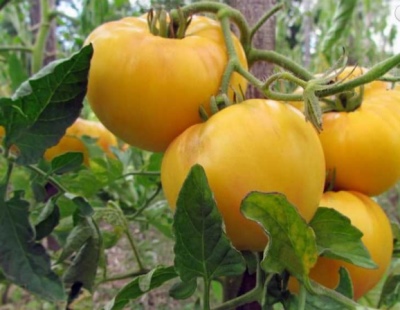
- Authors: Vasilevsky V. A., Korochkin V. L., Korotkov S. A., Kochkin A. V. (JSC Scientific and Production Corporation "NK. LTD")
- Year of approval: 2000
- Category: grade
- Growth type: indeterminate
- Appointment: fresh consumption, for juice
- Ripening period: mid-season
- Ripening time, days: 110-120
- Growing conditions: for open ground, for film greenhouses
- Bush size: tall
- Bush height, cm: up to 200
Increasingly, yellow-fruited varieties are found in household plots among the usual red-colored tomatoes. One of these varieties is Lemon Giant. In addition to the taste and visual advantages of its fruits, it can also be noted that, having bought a pack of seeds once, then you can collect your own seed material every year. All the qualities and merits of the variety will be repeated without changes.
Breeding history
A relatively young variety of tomatoes was the fruit of the work of a group of breeders who work at the Scientific and Production Corporation “NK. LTD ". Its authors - Vasilevsky V.A., Korochkin V.L., Korotkov S.A., Kochkin A.V. In 2000, 2 years after filing an application for entry into the State Register of Breeding Achievements, the variety was registered.
Description of the variety
The lemon giant is a mid-season tomato variety. Culture is indeterminate. The plant is tall, its height in greenhouse conditions reaches 2 m. The bushes are powerful. The inflorescences are simple, the first of them in the Giant Lemon is formed above 7-9 leaves. Further - after 3 sheets.
Medium foliage, with long internodes. Leaves are green, medium in size. Can be grown both in greenhouses and outdoors.
The main qualities of the fruit
Unripe fruits are green, with a dark green spot near the stalk; when fully ripe, the tomato completely acquires a beautiful light yellow color.
Fruits are flat-round, very large, uneven. When grown in a greenhouse, they can reach a weight of 900 g. To grow huge fruits, no more than three tomatoes are left on a branch.
The average weight of tomatoes grown in a garden bed is about 350-380 g. A stem with an articulation. Tomatoes are resistant to cracking. They are well stored and can be transported.
Consumed fresh. This pulpy, lemon-colored fruit will help add color to your vegetable salad. You can make vegetable juice.
Taste characteristics
Excellent taste. The skin is thin, underneath it is homogeneous in texture, sweet, with a slight sourness and light notes of lemon, pulp. The seed chambers are very small, almost invisible in the mouth.
Ripening and fruiting
After the emergence of seedlings, an average of 4 months (110-120 days) pass until the fruiting period. The harvest period is in the second half of the summer.
Yield
The lemon giant is characterized by high yields - about 6.1-6.7 kg / sq. m. From the Lemon Giant bush, you can collect about 4-6 kg of light yellow tomatoes.
The timing of planting seedlings and planting in the ground
They are planted in seedlings. Sowing is carried out in February-March, for this they use fertile, loose, well-moistened soil, to a depth of 1-2 cm. It is recommended to cover the seedlings with a film, which is removed after the first shoots appear. At a temperature of 20-25 degrees Celsius, seeds usually germinate on the 5th day.
After real leaves appear (2-3 pieces), the plants dive.
Lemon giant tomato seedlings are planted in the greenhouse in April-May, in open ground - in June, when morning frosts are no longer terrible.

Growing tomato seedlings is an extremely important process, because it largely depends on whether the gardener will be able to harvest at all.All aspects must be taken into account, from seedbed preparation to planting in the ground.
Landing scheme
The planting scheme is 40 by 60 cm. They are planted in prepared pits, well watered when planting.

Growing and care
Tomatoes of this variety are large, so that the stems do not break under their weight, they must be tied up.
A bush is formed into 1 stem, in the open field it can be formed into 2.
The Giant Lemon variety is prone to "fattening", with too frequent application of mineral fertilizers, fruiting worsens, the plant builds up the "green part" too quickly.
You need to water it with warm, settled water, avoiding overflow - excess moisture is harmful to tomatoes. Although Lemon Giant fruits are not prone to cracking, you should still avoid long periods without watering the soil. Otherwise, due to a sharp change in moisture content, cracks on the skin may still appear.




A plant needs different micronutrients at each stage of growth. All fertilizers can be divided into two groups: mineral and organic. Folk remedies are often used: iodine, yeast, bird droppings, eggshells.
It is important to observe the rate and period of feeding. This also applies to folk remedies and organic fertilizers.
Disease and pest resistance
The lemon giant tomato is not very resistant to most diseases. You should not forget about preventive treatments. It is imperative to carry out treatment for late blight and other fungal diseases of tomatoes (fusarium, wilting of tomatoes).


Resistant to adverse weather conditions
The variety is characterized by susceptibility to high temperatures and humidity (especially important in greenhouse conditions).To prevent the plant from shedding flowers and not dropping the ovaries, it is necessary to ventilate the film shelter.
Growing regions
It is possible to cultivate lemon Giant tomatoes almost throughout Russia.
Review overview
Tomato growers speak of this variety as rather capricious, demanding to comply with the rules of agricultural technology. Lemon Giant is not recommended for novice gardeners. Of the advantages of the variety, they call excellent taste and large-fruited. For many, Giant Lemon becomes one of the most favorite varieties of tomatoes.

























































































